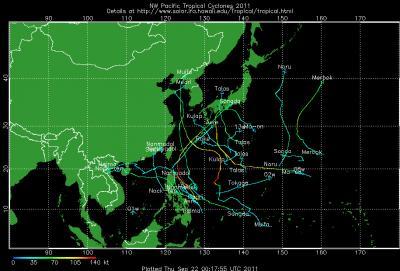Predicting weather events is more mysticism than science and it's only after the fact that predictions are recalibrated to try and hone in on more accuracy. Hurricane Sandy in the eastern United States was predicted to be a super-storm but by the time it hit New York City was a regular old tropical storm, though one that became a welcome $17 billion federal stimulus plan and a call for action on global warming that did not cause it.
Rainfall and number of tropical storms during the summer monsoon season is also inaccurate, though its impact on the agriculture, economy, and people in Asia is far more substantial. Researchers working at the International Pacific Research Center, University of Hawaii at Manoa, say they have made a promising breakthrough for predicting both the summer monsoon rainfall over East Asia and the number of tropical storms affecting East Asian coastal areas.
They show that both the East Asian summer monsoon and the storm activity in the western North Pacific are controlled by fluctuations in the western Pacific Subtropical High (WPSH), a major atmospheric circulation system in the global subtropics centered over the Philippine Sea. When this system is strong in summer, then monsoon rainfall tends to be greater than normal over East Asia, and in the western North Pacific there tend to be fewer tropical storms that make landfall.

This shows Tropical Storms in the western North Pacific in 2011. Credit: Institute for Astronomy, University of Hawaii at Manoa
With the help of computer modeling experiments, the scientists found that these summer fluctuations in the WPSH are more than 65% predictable in spring. When the Indo-Pacific warm pool shows a dipolar sea surface temperature anomaly (that is, an unusually warm Indian Ocean together with an unusually cool western North Pacific) or the central Pacific tends to cool in spring, then the WPSH will be strong and stable with ensuing greater summer monsoon rainfall over the East Asian monsoon front and the Ganges River Valley in India, but fewer tropical storms will affect East Asian coastal areas and the western subtropical Pacific. The team traced the rainfall and storm variability in the Asian monsoon region to the feedback occurring between the WPSH and the underlying Indo-Pacific warm-pool ocean.
"Our findings create a promising way for predicting monsoon rainfall and tropical storm days during the East Asian summer," concludes lead author Bin Wang, meteorology professor at the University of Hawaii at Manoa and faculty at the International Pacific Research Center. "As a first step, we use global general circulation models to predict the fluctuations in the WPSH, and then in a second step, we use this forecast to predict rainfall and storm days in regional analyses. We have done hindcasts from 1979 to 2009 using this approach and have found substantially improved skills over the use of dynamical climate models in predicting the East Asian Summer Monsoon rainfall and tropical storm activity."




Comments